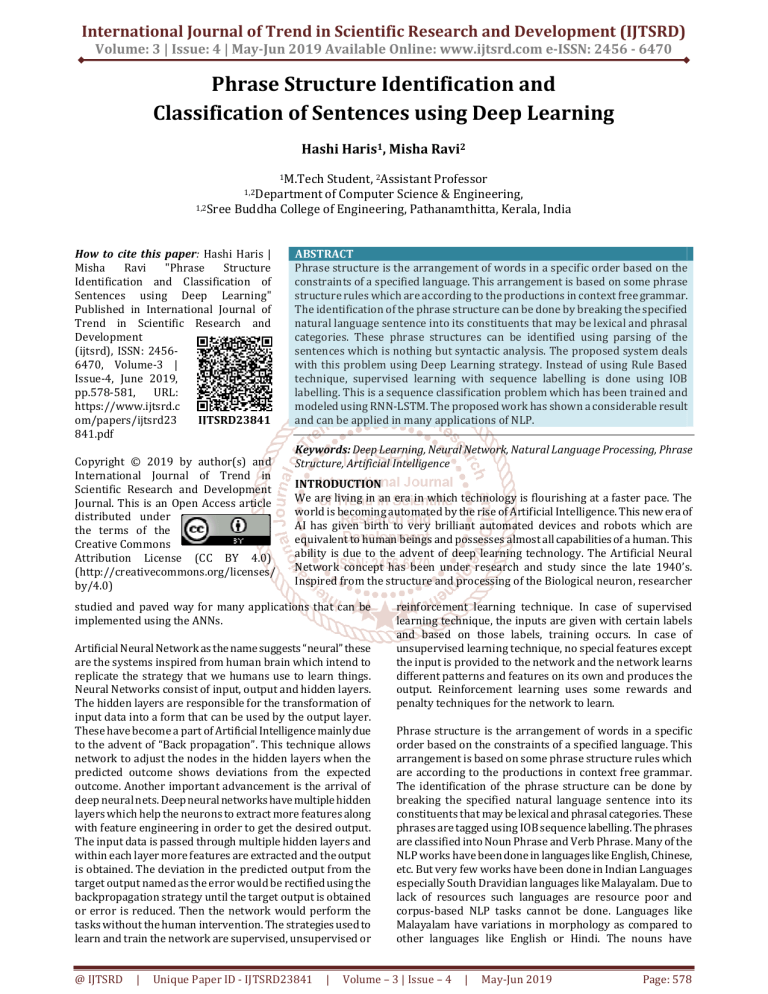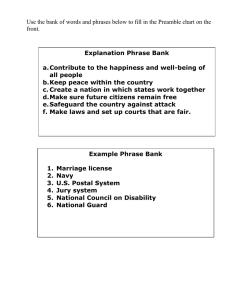
International Journal of Trend in Scientific Research and Development (IJTSRD)
Volume: 3 | Issue: 4 | May-Jun 2019 Available Online: www.ijtsrd.com e-ISSN: 2456 - 6470
Phrase Structure Identification and
Classification of Sentences using Deep Learning
Hashi Haris1, Misha Ravi2
1M.Tech
Student, 2Assistant Professor
of Computer Science & Engineering,
1,2Sree Buddha College of Engineering, Pathanamthitta, Kerala, India
1,2Department
How to cite this paper: Hashi Haris |
Misha
Ravi
"Phrase
Structure
Identification and Classification of
Sentences using Deep Learning"
Published in International Journal of
Trend in Scientific Research and
Development
(ijtsrd), ISSN: 24566470, Volume-3 |
Issue-4, June 2019,
pp.578-581,
URL:
https://www.ijtsrd.c
om/papers/ijtsrd23
IJTSRD23841
841.pdf
Copyright © 2019 by author(s) and
International Journal of Trend in
Scientific Research and Development
Journal. This is an Open Access article
distributed under
the terms of the
Creative Commons
Attribution License (CC BY 4.0)
(http://creativecommons.org/licenses/
by/4.0)
ABSTRACT
Phrase structure is the arrangement of words in a specific order based on the
constraints of a specified language. This arrangement is based on some phrase
structure rules which are according to the productions in context free grammar.
The identification of the phrase structure can be done by breaking the specified
natural language sentence into its constituents that may be lexical and phrasal
categories. These phrase structures can be identified using parsing of the
sentences which is nothing but syntactic analysis. The proposed system deals
with this problem using Deep Learning strategy. Instead of using Rule Based
technique, supervised learning with sequence labelling is done using IOB
labelling. This is a sequence classification problem which has been trained and
modeled using RNN-LSTM. The proposed work has shown a considerable result
and can be applied in many applications of NLP.
Keywords: Deep Learning, Neural Network, Natural Language Processing, Phrase
Structure, Artificial Intelligence
INTRODUCTION
We are living in an era in which technology is flourishing at a faster pace. The
world is becoming automated by the rise of Artificial Intelligence. This new era of
AI has given birth to very brilliant automated devices and robots which are
equivalent to human beings and possesses almost all capabilities of a human. This
ability is due to the advent of deep learning technology. The Artificial Neural
Network concept has been under research and study since the late 1940’s.
Inspired from the structure and processing of the Biological neuron, researcher
studied and paved way for many applications that can be
implemented using the ANNs.
Artificial Neural Network as the name suggests “neural” these
are the systems inspired from human brain which intend to
replicate the strategy that we humans use to learn things.
Neural Networks consist of input, output and hidden layers.
The hidden layers are responsible for the transformation of
input data into a form that can be used by the output layer.
These have become a part of Artificial Intelligence mainly due
to the advent of “Back propagation”. This technique allows
network to adjust the nodes in the hidden layers when the
predicted outcome shows deviations from the expected
outcome. Another important advancement is the arrival of
deep neural nets. Deep neural networks have multiple hidden
layers which help the neurons to extract more features along
with feature engineering in order to get the desired output.
The input data is passed through multiple hidden layers and
within each layer more features are extracted and the output
is obtained. The deviation in the predicted output from the
target output named as the error would be rectified using the
backpropagation strategy until the target output is obtained
or error is reduced. Then the network would perform the
tasks without the human intervention. The strategies used to
learn and train the network are supervised, unsupervised or
@ IJTSRD
|
Unique Paper ID - IJTSRD23841
|
reinforcement learning technique. In case of supervised
learning technique, the inputs are given with certain labels
and based on those labels, training occurs. In case of
unsupervised learning technique, no special features except
the input is provided to the network and the network learns
different patterns and features on its own and produces the
output. Reinforcement learning uses some rewards and
penalty techniques for the network to learn.
Phrase structure is the arrangement of words in a specific
order based on the constraints of a specified language. This
arrangement is based on some phrase structure rules which
are according to the productions in context free grammar.
The identification of the phrase structure can be done by
breaking the specified natural language sentence into its
constituents that may be lexical and phrasal categories. These
phrases are tagged using IOB sequence labelling. The phrases
are classified into Noun Phrase and Verb Phrase. Many of the
NLP works have been done in languages like English, Chinese,
etc. But very few works have been done in Indian Languages
especially South Dravidian languages like Malayalam. Due to
lack of resources such languages are resource poor and
corpus-based NLP tasks cannot be done. Languages like
Malayalam have variations in morphology as compared to
other languages like English or Hindi. The nouns have
Volume – 3 | Issue – 4
|
May-Jun 2019
Page: 578
International Journal of Trend in Scientific Research and Development (IJTSRD) @ www.ijtsrd.com eISSN: 2456-6470
inflections due to to case, gender and number information.
The verbs are inflected due to tense, aspect and mood
information [1].
The state of the art is to identify the phrase structure of
Malayalam language by breaking the sentence into phrases
mainly Noun Phrase and Verb Phrase and tag the phrases
using suitable IOB tags. Sequence labelling is the strategy
applied in NLP for various applications such as named entity
recognition, the proposed work is done by applying this
strategy. The identification and classification have been done
using deep learning. Several deep neural networks are
available but for this purpose RNN (Recurrent Neural
Network) is used since it is proved to be efficient in sentence
structure representations. Long Short-Term Memory Units
(LSTM) which is a variety of RNN is used so as to overcome
some drawbacks of RNN.
A. RELATED WORKS
1. Convolutional Neural Networks
Convolutional neural networks have been used in many NLP
tasks so far such as the pos tagging, chunking, sentence
modeling, etc. CNNs are designed in such a way that can
capture more important features from sentences. Works
have been reported in literature on sentence classification.
Such a work done by Kim [2] on sentence classification tasks
like question type classification, sentiment, subjectivity
classification. But this vanilla network had difficulty in
modeling long distance dependencies. This issue was solved
by designing a dynamic convolutional neural network. CNNs
require large training data in developing semantic models
with contextual window. This becomes an issue when data
scarcity occurs. Another issue with CNNs is they find
difficulty in preserving sequential data.
2. Sentence ordering and coherence modeling using
RNN
Modeling the structure of coherent texts is a key NLP
problem. The task of coherently organizing a given set of
sentences has been commonly used to build and evaluate
models that understand such structure. An end-to-end
unsupervised deep learning approach based on the set-tosequence framework is proposed to address this problem
[3]. RNNs are now the dominant approach to sequence
learning and mapping problems. An RNN-based approach to
the sentence ordering problem which exploits the set-tosequence framework of Vinyals, Bengio, and Kudlur (2015)
is proposed. The model is based on the read, process and
write framework. The model is comprised of a sentence
encoder RNN, an encoder RNN and a decoder RNN.
3. Deep learning for sentence classification
Neural network-based methods have obtained great
progress on a variety of natural language processing tasks.
The primary role of the neural models is to represent the
variable-length text as a fixed-length vector [4]. These
models generally consist of a projection layer that maps
words, sub-word units or n-grams to vector representations
(often trained beforehand with unsupervised methods), and
then combine them with the different architectures of neural
networks. Recurrent neural networks (RNN) are one of the
most popular architectures used in NLP problems because
their recurrent structure is very suitable to process the
variable-length text. A recurrent neural network (RNN)
[Elman, 1990] is able to process a sequence of arbitrary
length by recursively applying a transition function to its
@ IJTSRD
|
Unique Paper ID - IJTSRD23841
|
internal hidden state vector ht of the input sequence. The
activation of the hidden state ht at time-step t is computed as
a function f of the current input symbol xt and the previous
hidden state ht-1. A simple strategy for modeling sequence is
to map the input sequence to a fixed-sized vector using one
RNN, and then to feed the vector to a softmax layer for
classification or other tasks.
B. PROPOSED SYSTEM
The proposed system titled “Phrase Structure Identification
and Classification of sentences using Deep Learning” for
Indian languages identifies the phrases within a Malayalam
sentence and classifies them into Noun and Verb Phrase.
Phrase Structure Grammar is an inevitable part of a
language. It helps to correctly frame a sentence in an order
based on the phrase structure rules. The proposed system
has a modern solution to the identification and classification
of phrases without the help of rules and no linguistic
knowledge is necessary which is possible through the most
trending hot technology named “Deep Learning”. The
relevance of phrase structure identification is checking the
grammar of a natural language becomes more accurate and
efficient if the phrases are identified correctly and it helps to
track the error within phrase level and it’s easy to rectify
those error phrases. Instead of taking into consideration the
entire document or sentence, phrase level identification
helps in easy error tracking and rectification of grammar.
Figure B.1: Architecture of Proposed System
Phrase Structure identification and classification has been
done by the combination of two modules:
1. Data Preprocessing
The proposed system can be generalized into a Text
Classification problem. Text Classification is a common task
in NLP which would transform a sequence of text with
indefinite length into a category of text. Data Preprocessing
is a major task in all Deep Learning applications. The input
data fed into the deep neural net must be in a pattern
compatible to the network. Basically, data preprocessing is
undergone through a series of steps like cleaning, stemming,
stop word removal etc. In the proposed system, the dataset
consists of Malayalam sentences. The preprocessing done
here is splitting the sentences into phrases. Each sentence
has a sentenced and its constituent phrases also have the
same sentence id. The dataset is represented using pandas
data frame. The work has been focused on word length three
Malayalam sentences from health and newspaper domain.
Volume – 3 | Issue – 4
|
May-Jun 2019
Page: 579
International Journal of Trend in Scientific Research and Development (IJTSRD) @ www.ijtsrd.com eISSN: 2456-6470
Next a representation of the input text is created so that it
could be fed into the deep learning model. The phrases in the
text are represented as vectors. The phrases are mapped into
a dictionary with a sequence of numbers and these numbers
are the vector representation of the phrases. These phrases
are then padded. Since it is classification model the phrases
are tagged into Noun and Verb phrase. These tag sequences
are represented as dictionary with sequence of numbers and
then padded. To train the model the tag sequences or the
labels are represented in a categorical format. The Noun
phrase and Verb phrase are labelled as NP and VP. Sequence
labelling is the strategy applied with IOB labels I-refers to
inside of a chunk, O- outside of a chunk, B- beginning of a
chunk. The proposed model is trained using supervised
learning and it’s a sequence or text classification task so the
labels are already tagged and the dataset is prepared in a
compatible manner to the DNN model.
2. Phrase Structure Identification and Classification
Training and Testing
The data that is given into the model has been preprocessed,
so the next task in a Deep Learning application is building up
a model. Recurrent Neural Networks are known to handle
sequential data and has been widely used and recommended
in literature for text classification tasks. Recurrent Neural
Networks are nothing but a chunk of neural network into
which input data is given and it outputs a hidden layer. This
single chunk of neural network represented as a loop forms
a Recurrent Neural Network as the name suggests, it is
recurrent in nature. But RNN’s have a drawback of vanishing
and exploding gradient problem. The neural networks work
based on a Backpropagation algorithm. This is done mainly
to backtrack the network and rectify the error. At the time of
backtracking the network, some gradient values get
vanished or some of them increase exponentially which
would lead to fault in prediction of the output. In theory
RNN’s can handle long term dependencies but in practice it
is found that RNN’s lack that ability. RNN’s can predict the
previous or the next information but it cannot accurately
predict the word or information that are at a larger distance
from the current input word, this is the long-term
dependency problem. To overcome these kinds of issues
persisting in RNN’s a variant of RNN named Long ShortTerm Memory Units (LSTM) are used.
C. BIDIRECTIONAL LSTM’S
Bidirectional LSTMs are an extension of traditional LSTMs
that can improve model performance on sequence
classification problems. In problems where all timesteps of
the input sequence are available, Bidirectional LSTMs train
two instead of one LSTMs on the input sequence. The first on
the input sequence as is and the second on a reversed copy
of the input sequence. This can provide additional context to
the network and result in faster and even fuller learning on
the problem. LSTM in its core, preserves information from
inputs that has already passed through it using the hidden
state. Unidirectional LSTM only preserves information of the
past because the only inputs it has seen are from the past.
Using bidirectional will run the inputs in two ways, one from
past to future and one from future to past and what differs
this approach from unidirectional is that, in the LSTM that
runs backwards we can preserve information from the
future and using the two hidden states combined we are able
in any point in time to preserve information from both past
and future .BiLSTMs show very good results as they can
understand context better.
@ IJTSRD
|
Unique Paper ID - IJTSRD23841
|
D. EXPERIMENTAL ANALYSIS
The Phrase Structure Classification model is defined then the
model is compiled and fit the model with all
hyperparameters. The first layer is an Embedding layer to
which the input is mapped. A functional Keras API is used to
build the model which uses Bidirectional LSTM with 100
memory units and recurrent dropout of 0.1. The activation
function used is softmax since it is suitable for binary
classification problems. The optimizer used is adam
optimizer which is widely used with binary cross entropy as
loss function. The model is compiled using the above
hyperparameters and it is fitted with batch size of 32 and 100
epochs. Once the model is trained, the model is undergone
testing by giving as input test data which are also phrases and
the model would classify the phrases by predicting them as
Noun Phrase and Verb Phrase.
For development of the proposed system following are the
requirements:
TensorFlow is an open-source software library used to
develop and deploy machine learning applications. Keras is
an open source neural network library written in Python. It
is designed for faster implementation of deep neural
networks. It is user friendly, modular and extensible. Jupyter
notebook is an interactive development environment to
designed to support interactive data science and scientific
computing across all programming languages. Pandas is a
software library designed for the Python programming
language for data manipulation and analysis. NumPy is a
Python programming language library that deals with multidimensional arrays, matrices and various mathematical
functions for operating on these arrays and matrices. The
performance required for the proposed system are:
Processor – Intel core i3 or higher RAM – 4GB or higher,
Speed – 1.80 Ghz or higher, OS – Ubuntu 16 or higher, Mac OS,
OS type-64-bit, Programming language – Python 3.6, Disk
space – 491.2 GB or higher.
E. Results
This section discusses the experimental results of the
proposed system. First of all, the proposed system uses
original Malayalam documents given by CDAC, Trivandrum
for results assessment. The proposed system is composed of
two modules. The first module named Data Preprocessing
module deals with converting Malayalam sentences into
phrases and labelling them with IOB tags. For word
embedding skip gram and cbow models were also
implemented. For the proposed system the embedding is
done by just encoding the input phrases into some integer
vectors. The second module which is the training and testing
phase of the proposed model named Phrase structure
identification and classification training and testing deals
with the development of the model which provided an
accuracy of 100% for 210 sentence phrases with validation
accuracy of 100% with training loss of 1.1286e-04 and
validation loss of 0.0395.
F. Analysis
The proposed system has been modeled as a Sequence
Classification Problem using a sequence labelling strategy
with RNN-Bidirectional LSTM. The following graphs show
the loss and accuracy curves.
Volume – 3 | Issue – 4
|
May-Jun 2019
Page: 580
International Journal of Trend in Scientific Research and Development (IJTSRD) @ www.ijtsrd.com eISSN: 2456-6470
which is just a miniature version of the problem and it can be
further improved with the help of more data. The Sequence
IOB labelling technique with Bidirectional lstms have given a
considerable accuracy with small loss percentage. The
proposed system can be further improved and used in the
development of many NLP tools. This strategy can be applied
for other languages also. But still there are various areas in
which deep learning is still in its childhood stage as in case of
processing with unlabeled data. But with the developing
researches it is expected that deep learning would become
more enhanced and can be applied in different areas.
H. ACKNOWLEDGMENT
The proposed work is an R&D project of CDAC-TVM. The
work was done under supervision of Knowledge Resource
Centre of CDAC-TVM. A sincere gratitude to CDAC-TVM for
providing an opportunity to work on their project, giving
permission to access their resources and guiding for the
successful completion of this work.
Figure D.b.1: Loss Curve
I. REFERENCES
[1] Latha R Nair and David peter S “Language Parsing and
Syntax of Malayalam Language” 2nd International
Symposium on Computer, Communication, Control and
Automation (3CA 2013)
[2] Y. Kim, “Convolutional neural networks for sentence
classification,” arXiv preprint arXiv:1408.5882, 2014.
Figure D.b.2: Accuracy Curve
G. CONCLUSION & FUTURE WORKS
Deep learning has been widely used in many NLP tasks as it
needs only little engineering by hand. The proposed system
is basically a sequence classification problem under NLP
which has been solved by applying supervised learning
strategy. RNN with LSTM has been used to train the model.
The proposed problem has been done only for 200 sentences
@ IJTSRD
|
Unique Paper ID - IJTSRD23841
|
[3] Lajanugen Logeswaran, Honglak Lee, Dragomir Radev
“Sentence Ordering and Coherence Modeling using
Recurrent Neural Networks”
[4] Pengfei Liu Xipeng Qiu and Xuanjing Huang “Recurrent
Neural Network for Text Classification with Multi-Task
Learning “Proceedings of the Twenty-Fifth
International Joint Conference on Artificial Intelligence
Volume – 3 | Issue – 4
|
May-Jun 2019
Page: 581





